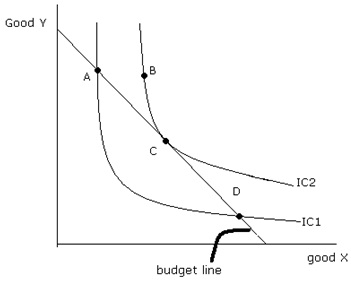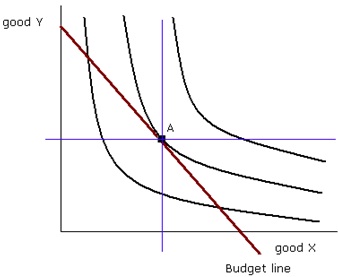Problem 1. Suppose one consumer wants to purchase clothes and books. Choose the necessary information to study the consumer’s choice.
(a) income of the consumer
(b) price of cloth
(c) price of books
(d) preferences of the consumer
(e) all of the above
Problem 2. Which is true for indifference curves?
(a) Lower indifference curves are prefered to higher ones.
(b) Along one I.C., every point represents a constant level of satisfaction.
(c) In general, I.C.s are upward sloping.
(d) Some I.C.s can cross, if income is very high.
(e) I.C.s are bowed inward, because the opportunity cost is increasing.
Problem 3. Draw the budget line in each case. For each case, calculate the slope and then compare cases (b) through (f) to case (a).
income price of X good price of Y good
(a) 100 10 5
(b) 100 10 20
(c) 100 5 5
(d) 200 10 5
(e) 50 10 5
(f) 200 20 10
Problem 4. Jack spends all of his income on books and CDs. The price of one book is $30 and the price of one CD is $20. Then, at his optimal choice of consumption, what’s the value of the slope of the indifference curve? (put the books on the X-axis and CDs on the Y-axis.)
(a) –2/3
(b) –3/2
(c) –20
(d) –30
(e) It depends on the size of his income.
Problem 5. The utility of John is represented by U(x,y)=x*y. This implies, if he consumes 4 units of x and 5 units of y, then his utility(degree of satifaction) is 4*5=20. Then find at least 5 choices which give him the utility of 100, and draw the indifference curve.
Problem 6. Determine which of the following are true or false.
(a) If X and Y are normal goods, then the income-consumption line is upward sloping.
(b) If X is an inferior good, then Y can be an inferior good also.
(c) The income-consumption line represents the relationship of the optimal choice to a change in the price of the good on the X-axis.
(d) If Y is an inferior good, then X must be a normal good.
(e) If X is an inferior good, then the optimal choice is not on the budget line.
Problem 7. Which of the following is true from the following graph?
(a) The consumer prefers A to C.
(b) The optimal choice is D.
(c) The consumer is indifferent between A and D.
(d) The optimal choice is B.
(e) C is prefered to B.

8. One consumer’s indifference curves and budget line are given in the following graph. A is the optimal choice given the budget line. If the income increases, the consumer chooses a point which is located northwest side of A.(There is no change in the prices.) What can we say about good X and good Y?
